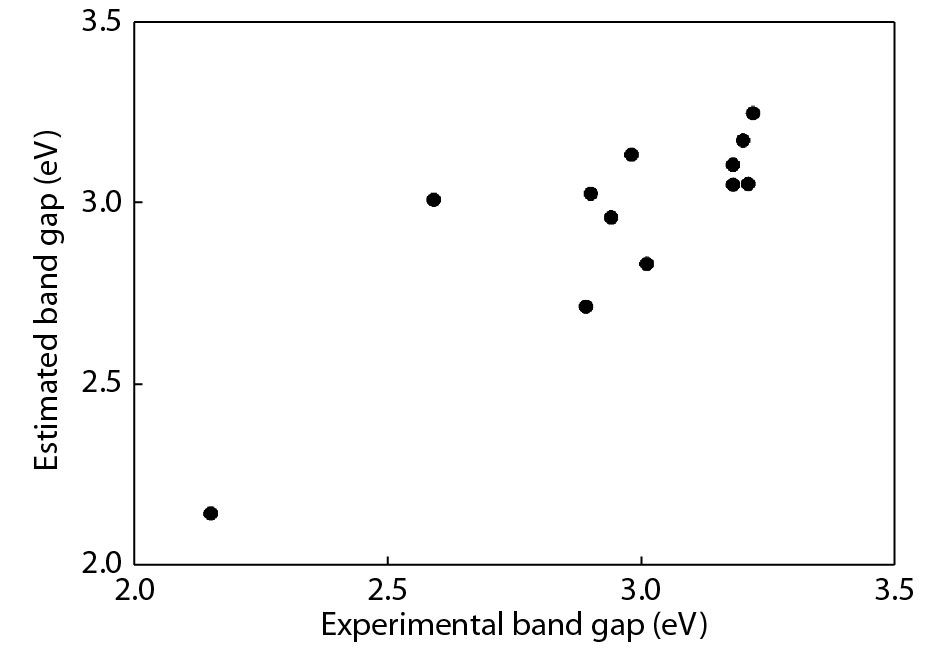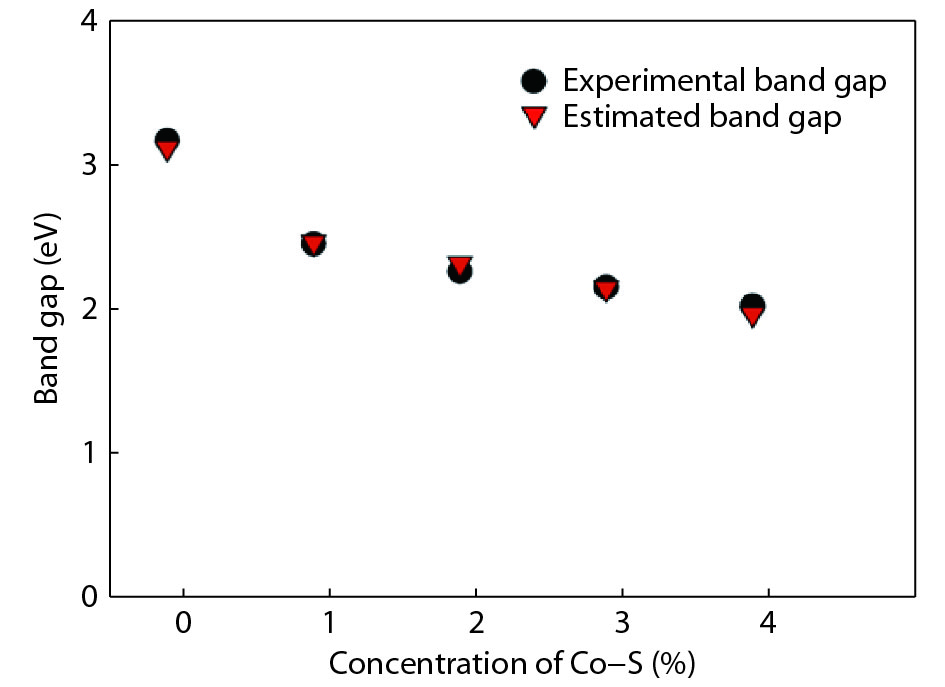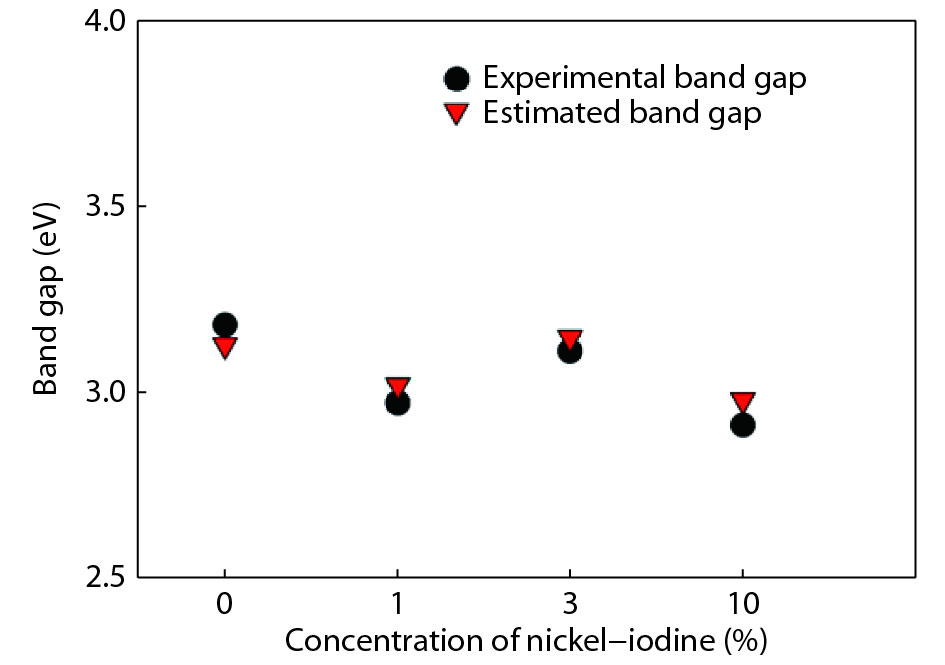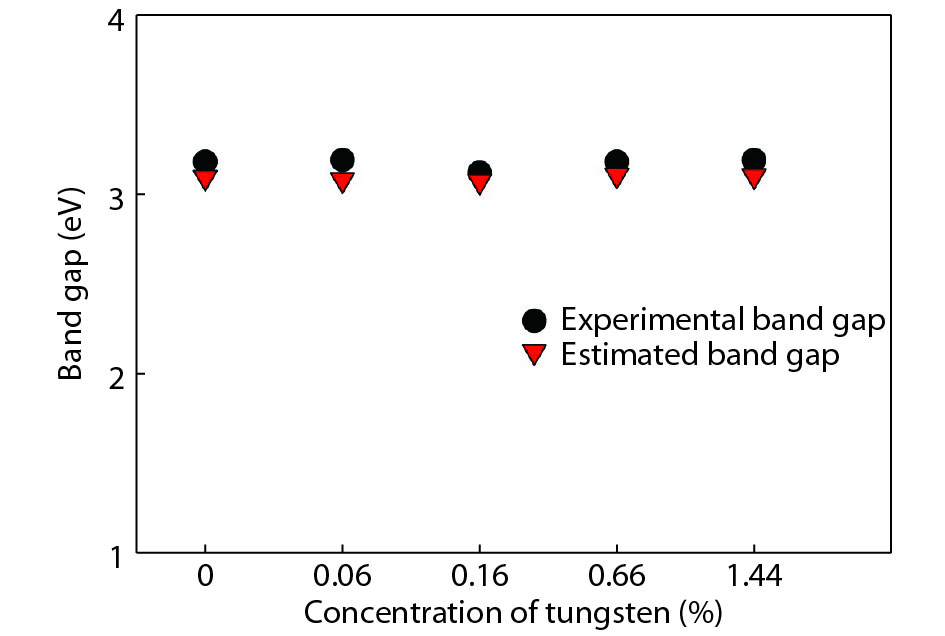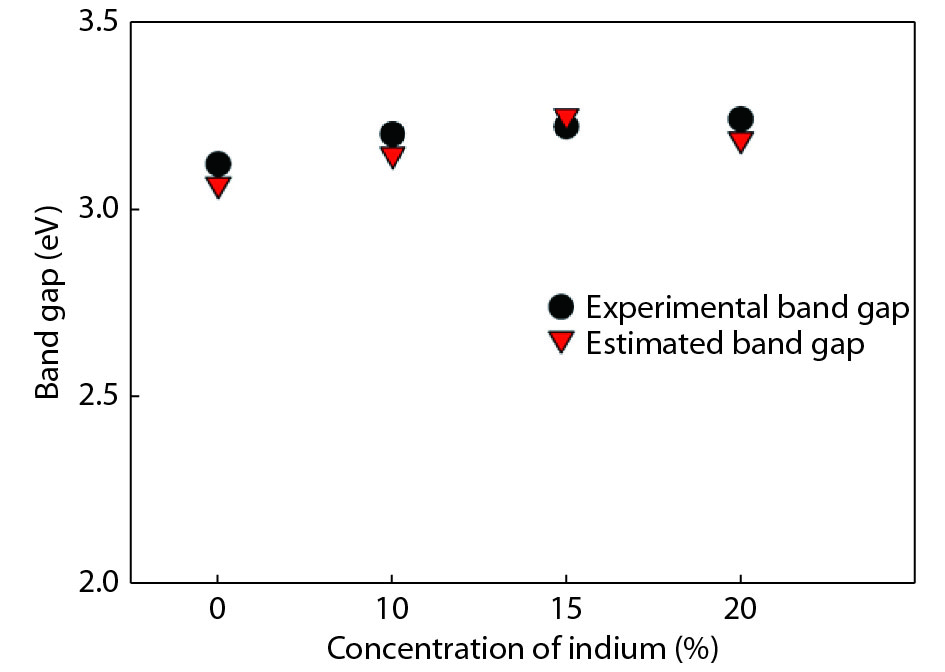| Citation: |
Taoreed O. Owolabi. Development of a particle swarm optimization based support vector regression model for titanium dioxide band gap characterization[J]. Journal of Semiconductors, 2019, 40(2): 022803. doi: 10.1088/1674-4926/40/2/022803
****
T O Owolabi, Development of a particle swarm optimization based support vector regression model for titanium dioxide band gap characterization[J]. J. Semicond., 2019, 40(2): 022803. doi: 10.1088/1674-4926/40/2/022803.
|
Development of a particle swarm optimization based support vector regression model for titanium dioxide band gap characterization
DOI: 10.1088/1674-4926/40/2/022803
More Information
-
Abstract
Energy band gap of titanium dioxide (TiO2) semiconductor plays significant roles in many practical applications of the semiconductor and determines its appropriateness in technological and industrial applications such as UV absorption, pigment, photo-catalysis, pollution control systems and solar cells among others. Substitution of impurities into crystal lattice structure is the most commonly used method of tuning the band gap of TiO2 for specific application and eventually leads to lattice distortion. This work utilizes the distortion in the lattice structure to estimate the band gap of doped TiO2, for the first time, through hybridization of a particle swarm optimization algorithm (PSO) with a support vector regression (SVR) algorithm for developing a PSO-SVR model. The precision and accuracy of the developed PSO-SVR model was further justified by applying the model for estimating the effect of cobalt-sulfur co-doping, nickel-iodine co-doping, tungsten and indium doping on the band gap of TiO2 and excellent agreement with the experimentally reported values was achieved. Practical implementation of the proposed PSO-SVR model would further widen the applications of the semiconductor and reduce the experimental stress involved in band gap determination of TiO2. -
References
[1] M Kumar, A K Gupta, D Kumar. Mg-doped TiO2 thin films deposited by low cost technique for CO gas monitoring. Ceram Int, 2015, 42(1): 405 doi: 10.1016/j.ceramint.2015.08.124[2] U Diebold. The surface science of titanium dioxide. Surf Sci Rep, 2003, 48(5–8): 53 doi: 10.1016/S0167-5729(02)00100-0[3] B Yacoubi, L Samet, J Bennaceur, et al. Properties of transition metal doped-titania electrodes: Impact on efficiency of amorphous and nanocrystalline dye-sensitized solar cells. Mater Sci Semicond Process, 2015, 30: 361 doi: 10.1016/j.mssp.2014.10.035[4] Sobczyk-Guzenda A, Owczarek S, Szymanowski H, et al. Iron doped thin TiO2 films synthesized with the RF PECVD method. Ceram Int, 20115, 41(6): 7496[5] M Hamadanian, S Karimzadeh, V Jabbari, et al. Synthesis of cysteine, cobalt and copper-doped TiO2 nanophotocatalysts with excellent visible-light-induced photocatalytic activity. Mater Sci Semicond Process, 2016. 41: 168 doi: 10.1016/j.mssp.2015.06.085[6] S A Ahmed. Annealing effects on structure and magnetic properties of Mn-doped TiO2. J Magn Magn Mater, 2016. 402: 178 doi: 10.1016/j.jmmm.2015.11.065[7] L Kernazhitsky, V Shymanovska, T Gavrilko, et al. Photoluminescence of Cr-doped TiO2 induced by intense UV laser excitation. J Lumin, 2015. 166: 253 doi: 10.1016/j.jlumin.2015.03.034[8] T Potlog, P Dumitriu, M Dobromir, et al. Nb-doped TiO2 thin films for photovoltaic applications. Mater Des, 2015. 85: 558. doi: 10.1016/j.matdes.2015.07.034[9] A Arunachalam, S Dhanapandian, C Manoharan, et al. Physical properties of Zn doped TiO2 thin films with spray pyrolysis technique and its effects in antibacterial activity. Spectrochim. Acta - Part A Mol Biomol Spectrosc, 2015. 138: 105. doi: 10.1016/j.saa.2014.11.016[10] M Mollavali, C Falamaki, S Rohani. Preparation of multiple-doped TiO2 nanotube arrays with nitrogen, carbon and nickel with enhanced visible light photoelectrochemical activity via single-step anodization. Int J Hydrogen Energy, 2015. 40: 12239. doi: 10.1016/j.ijhydene.2015.07.069[11] A Siddiqa, D Masih, D Anjum, et al. Cobalt and sulfur co-doped nano-size TiO2 for photodegradation of various dyes and phenol. J Environ Sci (China), 2015. 37: 100 doi: 10.1016/j.jes.2015.04.024[12] C McManamon, J O’Connell, P Delaney, et al. A facile route to synthesis of S-doped TiO2 nanoparticles for photocatalytic activity. J Mol Catal.A Chem, 2015. 406: 51 doi: 10.1016/j.molcata.2015.05.002[13] Kaneda Y, Mineno H. Sliding window-based support vector regression for predicting micrometeorological data. Expert Syst Appl, 216. 59: 217.[14] K O Akande, T O Owolabi, S O Olatunji, et al. A novel homogenous hybridization scheme for performance improvement of support vector machines regression in reservoir characterization. Appl Comput Intell Soft Comput, 2016. 2016: 1. doi: 10.1155/2016/2580169[15] T O Owolabi, K O Akande, S O Olatunji. Computational intelligence method of estimating solid- liquid interfacial energy of materials at their melting temperatures. J Intell Fuzzy Syst, 2016. 31: 519 doi: 10.3233/IFS-162164[16] T O Owolabi, K O Akande, S O Olatunji. Computational intelligence approach for estimating superconducting transition temperature of disordered MgB2 superconductors using room temperature resistivity. Appl Comput Intell Soft Comput, 2016, 2016: 1709827 doi: https://doi.org/10.1016/j.asoc.2016.02.005[17] T O Owolabi, K O Akande, S O Olatunji. Estimation of average surface energies of transition metal nitrides using computational intelligence technique. Soft Comput, 2017, 21: 6175 doi: 10.1007/s00500-016-2174-2[18] T O Owolabi, M Faiz, S O Olatunji, et al. Computational intelligence method of determining the energy band gap of doped ZnO semiconductor. Mater Des, 2016, 101: 277 doi: 10.1016/j.matdes.2016.03.116[19] M A Suleiman, T O Owolabi, H B Adeyemo, et al. Modeling of autoignition temperature of organic energetic compounds using hybrid intelligent method. Process Saf Environ Prot, 2018, 120: 79 doi: 10.1016/j.psep.2018.08.031[20] Ghorbani M, Zargar G, Jazayeri-Rad H. Prediction of asphaltene precipitation using support vector regression tuned with genetic algorithms. 2016, 2:301 doi: 10.1016/j.petlm.2016.05.006[21] L Zhou, K K Lai, L Yu. Credit scoring using support vector machines with direct search for parameters selection. Soft Comput, 2009, 13(2): 149 doi: 10.1007/s00500-008-0305-0[22] P J G Nieto, J R A Fernández, V M G Suárez, et al. A hybrid PSO optimized SVM-based method for predicting of the cyanotoxin content from experimental cyanobacteria concentrations in the Trasona reservoir: A case study in Northern Spain. Appl Math Comput, 2015, 260: 170 doi: 10.1016/j.amc.2015.03.075[23] P J Garcia Nieto, E Garcia-Gonzalo, F Sanchez Lasheras, et al. Hybrid PSO-SVM-based method for forecasting of the remaining useful life for aircraft engines and evaluation of its reliability. Reliab Eng Syst Saf, 2015, 138: 219 doi: 10.1016/j.ress.2015.02.001[24] J Kennedy, R Eberhart. Particle swarm optimization. IEEE International Conference on Particle swarm optimization, 1995, 4: 1942[25] Vapnik V. The nature of statistical learning theory. Springer, 1995[26] X Zhang, P Wang, D Liang, et al. A soft self-repairing for FBG sensor network in SHM system based on PSO-SVR model reconstruction. Opt Commun, 2015, 343: 38 doi: 10.1016/j.optcom.2014.12.079[27] D Basak, S Pal, D C Patranabis. Support vector regression. Neural Inf Process Lett Rev, 2007, 11(10):. doi: 10.1007/978-1-4302-5990-9_4[28] R D A Timoteo, L N Silva, D C Cunha, et al. An approach using support vector regression for mobile location in cellular networks. Comput Networks, 2016, 95: 51 doi: 10.1016/j.comnet.2015.12.003[29] A Nazari, J G Sanjayan. Modelling of compressive strength of geopolymer paste, mortar and concrete by optimized support vector machine. Ceram Int, 2015, 41(9B): 12164 doi: 10.1016/j.ceramint.2015.06.037[30] M A Abido. Optimal power flow using particle swarm optimization. Int J Electr Power Energy Syst, 2002, 24(7): 563 doi: 10.1016/S0142-0615(01)00067-9[31] W Khan, S Ahmad, M M Hassan, et al. Structural phase analysis , band gap tuning and fluorescence properties of Co doped TiO2 nanoparticles. Opt Mater (Amst), 2016, 38: 278 doi: 10.1016/j.optmat.2014.10.054[32] E O Oseghe, P G Ndungu, S B Jonnalagadda. Photocatalytic degradation of 4-chloro-2-methylphenoxyacetic acid using W-doped TiO2. J Photochem Photobiol A Chem, 2015, 312: 96 doi: 10.1016/j.jphotochem.2015.07.014[33] M Tahir, N S Amin. Photocatalytic CO2 reduction with H2 as reductant over copper and indium co-doped TiO2 nanocatalysts in a monolith photoreactor. Appl Catal A Gen, 2015, 493: 90 doi: 10.1016/j.apcata.2014.12.053[34] I Rangel-Vazquez, et al. Synthesis and characterization of Sn doped TiO2 photocatalysts: Effect of Sn concentration on the textural properties and on the photocatalytic degradation of 2,4-dichlorophenoxyacetic acid. J Alloys Compd, 2015, 643(S1): S144 doi: 10.1016/j.jallcom.2014.12.065[35] Y H Lin, T K Tseng, H Chu. Photo-catalytic degradation of dimethyl disulfide on S and metal-ions co-doped TiO2 under visible-light irradiation. Appl Catal A Gen, 2014, 469: 221. doi: 10.1016/j.apcata.2013.10.006[36] L Yu, X Yang, J He, Y He, et al. One-step hydrothermal method to prepare nitrogen and lanthanum co-doped TiO2 nanocrystals with exposed {001} facets and study on their photocatalytic activities in visible light. J Alloys Compd, 2015, 637: 308. doi: 10.1016/j.jallcom.2015.03.035[37] X F Lei, X X Xue, H Yang. Preparation and characterization of Ag-doped TiO2 nanomaterials and their photocatalytic reduction of Cr(VI) under visible light. Appl Surf Sci, 2014, 321: 396 doi: 10.1016/j.apsusc.2014.10.045[38] T O Owolabi, K O Akande, S O Olatunji. Development and validation of surface energies estimator (SEE) using computational intelligence technique. Comput Mater Sci, 2015, 101: 143 doi: 10.1016/j.commatsci.2015.01.020[39] A Majid, A Khan, G Javed, et al. Lattice constant prediction of cubic and monoclinic perovskites using neural networks and support vector regression. Comput Mater Sci, 2010, 50(2): 363 doi: 10.1016/j.commatsci.2010.08.028[40] C Z Cai, G L Wang, Y F Wen, et al. Superconducting transition temperature T c estimation for superconductors of the doped MgB2 system using topological index via support vector regression. J Supercond Nov Magn, 2010, 23(5): 745 doi: 10.1007/s10948-010-0727-7[41] C Z Cai, T T Xiao, J L Tang, et al. Analysis of process parameters in the laser deposition of YBa2Cu3O7 superconducting films by using SVR. Phys C Supercond, 2013, 493: 100 doi: 10.1016/j.physc.2013.03.038[42] T O Owolabi, K O Akande, S O Olatunji. Estimation of superconducting transition temperature T C for superconductors of the doped MgB2 system from the crystal lattice parameters using support vector regression. J Supercond Nov Magn, 2014. doi: 10.1007/s10948-014-2891-7[43] A E Giannakas, M Antonopoulou, Y Deligiannakis, et al. Preparation, characterization of N-I co-doped TiO2 and catalytic performance toward simultaneous Cr(VI) reduction and benzoic acid oxidation. Appl Catal B Environ, 2013, 140/141: 636 doi: 10.1016/j.apcatb.2013.04.052[44] M Tahir, N S Amin. Indium-doped TiO2 nanoparticles for photocatalytic CO2 reduction with H2O vapors to CH4. Appl Catal B Environ, 2015, 162: 98 doi: 10.1016/j.apcatb.2014.06.037 -
Proportional views





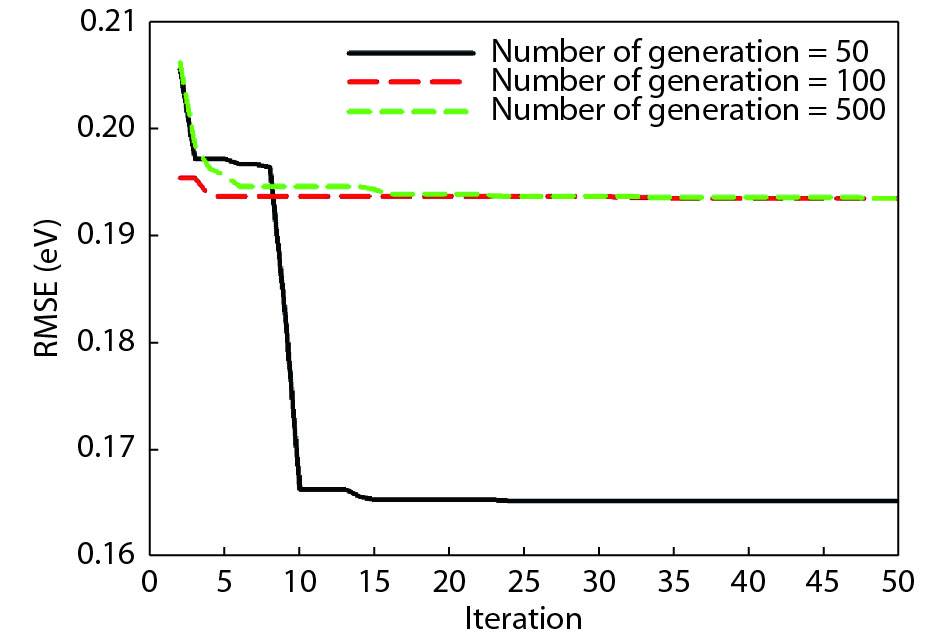
 DownLoad:
DownLoad:
